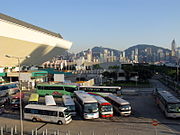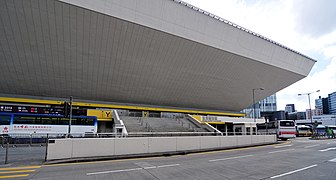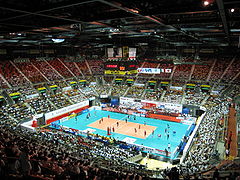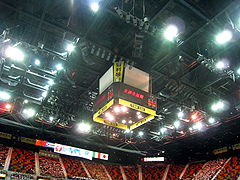Hong Kong Coliseum
| Hong Kong Coliseum 香港 體育館 |
|
|---|---|

|
|
| The Hong Kong Coliseum (2008) | |
| Data | |
| place | 9 Cheong Wan Road, Hung Hom, Kowloon, Hong Kong , China |
| Coordinates | 22 ° 18 '5.9 " N , 114 ° 10' 55.3" E |
| owner | Hong Kong Administration |
| operator | Leisure and Cultural Services Department (LCSD) |
| start of building | March 1973 |
| opening | April 27, 1983 |
| Renovations | 2008 |
| surface |
Concrete PVC - Flooring parquet ice |
| costs | HKD 140 million (1983) HKD 160 million (2008) |
| capacity | 10,500 seats 12,500 seats (concerts, maximum) |
| playing area | 41 × 41 m |
| Events | |
The Hong Kong Coliseum , or HKC for short ( Chinese 香港 體育館 / 香港 体育馆 , Pinyin Xiānggǎng Tǐyùguǎn , Jyutping Hoeng 1 gong 2 Tai 2 juk 6 gun 2 ), locally also known as the Hung Hom Coliseum ( 紅 磡 體育館 / 红 磡 体育馆 , Hóngkàn Tǐyùguǎn , Tǐyùguǎn Jyutping Hung 4 ham 3 Tai 2 juk 6 gun 2 , 紅館 / 红馆 for short , Hóngguǎn , Jyutping Hung 4 gun 2 ) is a multi-purpose hall in the Chinese Special Administrative Region of Hong Kong . It offers space for up to 12,500 people at concerts and is therefore the second largest event building in Hong Kong after the AsiaWorld arena, which opened in 2005 . The main central usable area of the arena is 1,680 square meters. In addition to the arena, conference rooms as well as VIP entrances and several receptions are part of the building complex. In addition to concerts , sports competitions such as volleyball , badminton , futsal ("five-a-side football"), short-distance swimming competitions or speed skating take place there.
history
The beginnings of building an event hall for Hong Kong began in the 1960s at what was then the “ Urban Council ” ( 市 政局 - “City Council or Administration Office”). The original plan to find suitable land in the city center on Hong Kong Island failed. After a long search, the then colonial government decided on the former Hung Hom Bay ( 紅磡灣 / 红磡湾 ) on the peninsula Kowloon land in the sea to win, since about the same time in the district of Hung Hom the then new ( "Kowloon Station" today Hung Hom train station ) including freight yard and warehouse ( 紅 磡 貨場 / 红 磡 货场 ) should be built for freight transport by rail ( KCR ). The foundation work for the arena was originally supposed to begin in March 1973. However, due to cost issues in the development of the building, work on the construction officially began in 1977. The building was completed in March 1981; it was opened on April 27, 1983 by Edward Youde , then the governor of Hong Kong . The city government contributed 23.5 million to the total of 140 million HKD construction costs. After the administrative authority "Urban Council" was dissolved in 2000 due to an administrative reform, today's "Leisure and Cultural Services Department" (LCSD, 康樂 及 文化 事務 署 / 康乐 及 文化 事务 署 , for short ) manages the facility.
On May 5, 1983, Hong Kong singer and actor Sam Hui held the very first concert in the then newly built Hong Kong Coliseum. Since then, the Hong Kong Coliseum has been one of the top event addresses for artists and singers in Hong Kong and Asia, in addition to sports events, as well as entertainment and show business .
renovation
The Hong Kong government invested HKD 160 million in 2008 to renovate and improve the Hong Kong Coliseum so that it could serve as the venue for the 2009 East Asian Games . The work lasted about six months from July 1, 2008 to January 27, 2009. The measures included, for example:
- Renewal of the furnishings in the reception and VIP rooms
- Revision of the lighting systems
- Renewal of the 10,500 seats in the grandstand
- Installation of a new display board system
- Installation of technical equipment for the award ceremony
- Repair of the stage technology to support the back and front stages
With the technically renewed and renovated facility, the Hong Kong Coliseum was able to resume normal operations on January 28, 2009.
Geography and traffic
The Hong Kong Coliseum is located in the Hung Hom district on the Kowloon peninsula, which is well-developed by traffic. The building is well connected to Hong Kong's public transport network and has an MTR subway stop below the building, which is on the "East" and "West Rail Line". It has parking spaces for bus and car traffic. In the immediate vicinity is the Hung Hom train station with direct train connections of the KCR to mainland China . Various regular buses ( Kowloon Motor Bus , New World First Bus , Citybus ), 19-seat minibuses (similar to shared taxis ) and taxis with connections to Tsim Sha Tsui -East ( TST -East for short ), New Territories and Hong Kong Island operate on Railway station. The event location is connected by car via the Cross-Harbor Tunnel and the urban highways of Route 1 and 4. The Hong Kong Polytechnic University is in the immediate vicinity .
- Hong Kong Coliseum traffic
“Coliseum” and parking lot , 2008
“Coliseum” and train station , 2006
photos
- Hong Kong Coliseum exterior
TST bank promenade
- Hong Kong Coliseum inside
FIVB competition, 2008
Events (selection)
- 1983: Sam Hui
- 1984: Eric Clapton - Money and Cigarettes World Tour
- 1990: Eric Clapton - Journeyman World Tour
- 1992: Futsal World Cup 1992
- 2002: Volleyball World Grand Prix 2002
- 2009: 5th East Asian Games
- 2011: Hong Kong Open (Badminton)
- 2013: SHE - Together Forever World Tour - Hong Kong
Web links
- Official website (Chinese, English)
Individual evidence
- ↑ LCSD: About Us - Location. In: www.lcsd.gov.hk. Retrieved July 9, 2019 (Chinese, English).
- ↑ LCSD: Hong Kong Coliseum - About the Coliseum. In: lcsd.gov.hk. April 27, 1983, accessed September 26, 2018 (English, Chinese).
- ↑ LCSD: Technical Information - Reference Only (PDF file; 699KB, English) at: lcsd.gov.hk , accessed on September 26, 2018 - Online
- ↑ 2 DECEMBER 1984 - ERIC CLAPTON & HIS BAND. In: www.whereseric.com. Retrieved July 25, 2019 .
- ↑ NOVEMBER 29, 1990 - ERIC CLAPTON & HIS BAND. In: www.whereseric.com. Retrieved July 25, 2019 .
- ^ Yonex Sunrise Hong Kong Open 2011. In: www.tournamentsoftware.com. Retrieved July 25, 2019 .
- ↑ HKC 2013 10 Calendar. (PDF file 775kB) In: www.lcsd.gov.hk. Retrieved July 25, 2019 .











